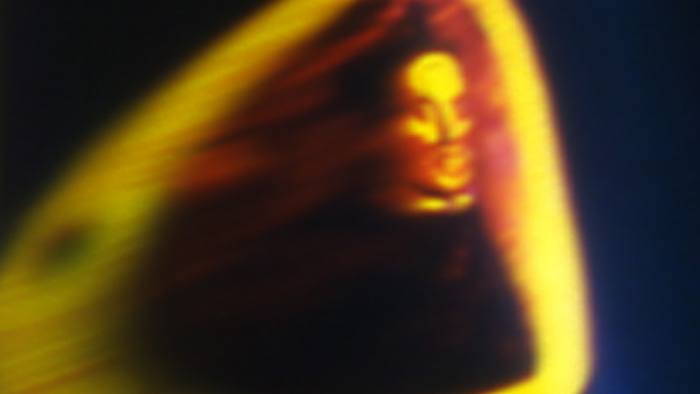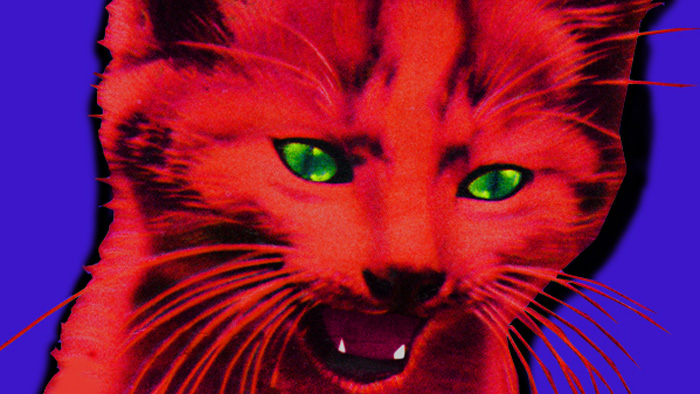KERRY LAITALA Mercurial Cinema
DOORS 8:00pm £5
San Francisco filmmaker Kerry Laitala is a gem of the cinematic underworld. Her long engagement with the avant garde processes of cinema position her as one of the most informed process-based artists workingwithin the medium. Harnessing glimmering, fluorescing light, macabre artefacts and an array of abandoned filmic devices and conventions, her films are a deep transgression into the al/chemical side of cinema. The films of Kerry Laitala evoke a glowing world in which spirits, memories and mouldering and artefacts swirl into feverish dreams recalling gothic conditions of poetry and decay. Seeming to hover on the borders of life and death, madness and sanity, these haunting alchemical films raise the dead from long slumbers to become luminous phantoms of flickering cinema.– Steve Polta, SF Cinematheque "Kerry Laitala takes eye-popping visual phenomena and turns it into refined artistry, in a body of work that is playful, visually articulate and a loving homage to the fundamental magic of cinema."
"Secure the Shadow...'Ere the Substance Fade"- 16mm, color, sound- 9 minutes 1997
"Secure the Shadow" is a meditation on disintegration and mortality; a lyrical Memento Mori. The film utilizes antique Medical stereoscopic images from the Victorian era, which are simultaneously disturbing and beautiful. The filmmaker's intention is to reveal universal truths about the overwhelming quality of disease to render us ultimately mute, immobilized within a corporeal shell that has succumbed to imminent forces beyond our control. The filmmaker also wants the film to address the myth that dignity is automatically restored upon the visage when facing death. In analyzing the original function of the stereoscopic images, the filmmaker intends to expose their classificatory nature. These anonymous subjects were reduced to paradigms of pathology, embalmed in time within their exterior presence. By re-photographing them on the optical printer and placing them in a mythical home, the filmmaker endeavors to re-animate these visages to ensnare them, or allow them to roam free on the surface of celluloid. Absence transforms to presence as the latent image reveals the manifest content, the slippery territories in between unraveling like the threads joining the crazy quilt that connects images together. An anachronistic Victorian sensibility places the images in a chimerical, historical context that embodies the film with a mind that is paradoxical and alien to our modern day perspective. The title "Secure the Shadow...'Ere the Substance Fade, let nature imitate what nature has made", comes from a Nineteenth century post mortem photographer who advertised his services. This reference speaks about the function of photography as a democratizing medium that assists in the process of mourning and serves as a physical reminder of loss.
Phantogram- 16mm, silent, 9 minutes, 2008 (Original material 35mm)
Shivery bits of elusive emulsion, refractive light sprays ignite the depths of two dimensions to expand the terrain of undulating forms. Vertical motion of frameless space testing the limits, “Phantogram” unites the torch and surface, forms made mobile. Indecipherable messages from the dead, a telepathic telegram captured on the medium of film…..The “redblind” refraction of elements explored, expand beyond the edges of the frame using sweeping gestures and textures both torn and tactile. Slippery shimmers slide across the celluloid strip, to embed themselves on the consciousness of viewers.
Legerdemain, 2- 16mm projectors, overhead projector, sound 8 minutes, sound-2009
"Legerdemain" speaks about the relationship of magicians and early cinema. Magicians played an important role in disseminating cinematic technology as they used the cinematograph in their acts and brought their spectacles to far reaching audiences around the globe. Legerdemain, meaning sleight-of hand, will use shadowgraphs and create enchanting optical illusions. Using a mixture of black and white and color film stocks, the film will have a stark appearance with undulating forms that move between abstract and more representational forms. "Legerdemain" will employ several types of shadows produced through images including elaborate Indonesian and Chinese Shadow puppets as well as simple bold shadow figures made using actual hands. The progression of images will include metaphoric allusions to the material of celluloid film, the apparatus and the screen.

Spectrology- 16mm, 12 minutes, sound, 2009
In 1646, Kircher published Ars Magna Lucis et Umbrae, on the subject of the display of images on a screen using an apparatus similar to the magic lantern as developed by Christian Huygens. Using this apparatus as a tool to enchant, spellbind and spook, Paul de Philipsthal, Robertson and other conjurors dazzled spectators with their unique bag of 18th Century tricks, raising up the spirits of recently deceased and reminding the viewer of the “fate that awaits us all”. “Spectrology” calls upon conjurors of the past and their secret repertoire of magical devices to simulate a modern rendition of the phantasmagoria. The medium of cinema is harnessed to entice the viewer and ruminate on the mesmerizing presence of various illusions made anew.
"Retrospectroscope"- 16mm, 5 minutes, silent, 1997
The “Retrospectroscope” apparatus has gone through many incarnations; its presence belies the processes that have created it. As a paracinematic device, it traces an evolutionary trajectory, encircling the viewer in a procession of flickering fantasies of fragmented lyricism. The “Retrospectroscope” is a reinvention that simulates the illusion of the analysis of motion to recall early mysteries of the quest for this very discovery now taken for granted. The “Muses of Cinema” represented by the female figures on the disk, have emerged from a dark Neoclassical past. Streams of images revolve around, in an attempt to harness notions of a cinematic prehistory tracing past motions and gestures to burn their dance on the surface of the retinas. This film known as the “Retrospectroscope", and was described in the San Francisco Bay Guardian as “A spinning flashing UFO/roulette wheel of Athenian proportions.”
"Hallowed"-16mm, 11 minutes, color, sound - 2002
"Hallowed" is a 16mm film that portrays a mystical voyage made back in time by an unconscious woman in the throes of a cataleptic state. She finds herself in Plato's cave where flickering flames incite a prehistoric cinematic reverie evoking an experience of magical proportions. She is a spectral being who is transformed from within as viewers witness a chasm between the physical self and psychical self become one. Her internal state is evoked through a chromatically textural metamorphosis that plays across her visage as she transcends the pain inflicted from an unknown source. Flames of purification melt away layers of trauma, and send the dislocated psyche back into the realm of the present as an integrated self. "Hallowed" evokes a transcendent state that could only be traversed and negotiated through the ritual contemplation of the elusive pictograms and archaic petroglyphs on the cave wall, as the realm of cinema becomes an antidote for the emptiness of earthly existence.
SPARKLE PLENTY - FILM/VIDEO HYBRID- 5.5 minutes, sound- 2009
Shot in an airport when I had a lot of time to kill, the title comes from a nickname my grandpa had for me when I was quite young.
Chromatic Frenzy: film/video hybrid- 7.5 minutes- 2009
Shot in my studio, frantic colored lights permeate the atmosphere. Vibrating swathes of color, penetrate the darkness; searchlight spectrums of suspended crystalline forms inspired by the likes of Wolfgang Von Goethe, Itten, Albers, Belson, Fischinger, Lye and the ever immortal Paul Sharits and Harry Smith. A colorful cauldron where primaries are mixed to create a cornucopia of suspended spectrums of light. Chromatic Frenzy delights the viewer with a colorful cauldron where primaries are mixed to create a cornucopia of suspended and refracted spectrums of light

Afterimage: A Flicker of Life: film/video hybrid, in Chromadepth, 12 minutes, sound, 2010
The Soundtrack: A Collage of Material by Nurse with Wound
Afterimage: A Flicker of Life incorporates etchings, archival photographs, inter-titles, found footage and live action material to create cinematic sequences of motion analysis. Beginning with an animated wood-cut of a beating heart, "Afterimage- A Flicker of Life" traces a trajectory of 19th Century photographer Edweard Muybridge and scientist Étienne-Jules Marey's works using the artifacts that they left behind. Afterimage- a Flicker of Life is an homage to Muybridge and Marey and a lyrical exploration of their motion studies providing a crucial link from still image to moving images and into the 21st Century using the three-dimensional technology. Human beings are reduced to their gestures and movements in space becoming forms of pure colored light. Afterimage- a Flicker of Life employs graphic tracings to create kinesthetic inscriptions that speak to the physicality of working with the film medium in a self-reflexive way. It also alludes to Marey's graphical inscriptions by incorporating the sine wave, which makes visible patterns and revolutionized our understanding of the physics of these phenomena. This technology is a direct descendent of the sphygmographe and other devices Marey invented that predates electro-cardiograms. The beating heart refers to his Marey's desire to make internal processes visible to the naked eye. Afterimage: A Flicker of Life takes a whimsical approach to envisaging human locomotion by illuminating the traces of their presence. By expanding the two-dimensional moving images into three dimensions, Afterimage ...also uses the technology of stereoscopy which was invented more than 50 years before motion pictures as we know them to create a greater sense of forms re-animated in space.

